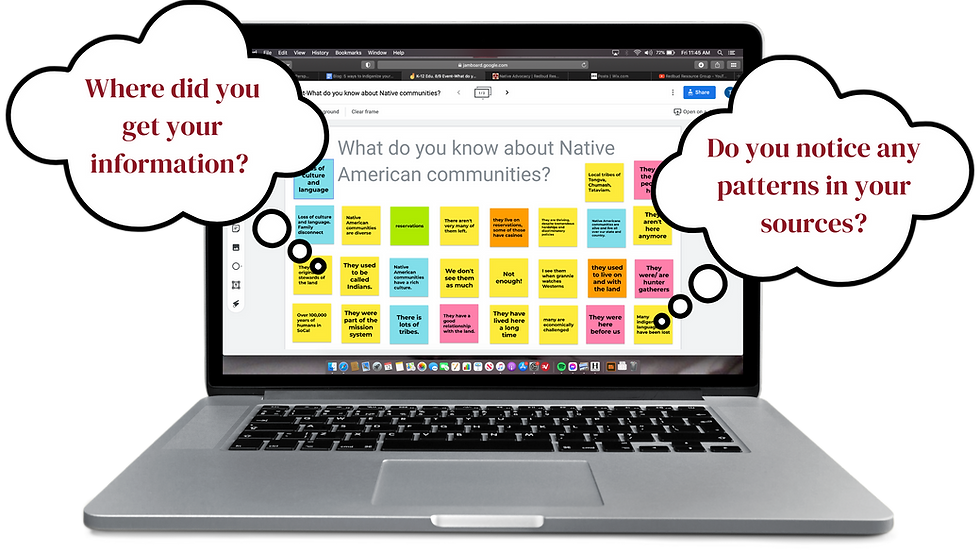5 ways to Indigenize your Pedagogy
- Redbud Resource Group

- Aug 24, 2022
- 3 min read
Updated: Dec 17, 2024
Blog Written by: Trelasa Baratta

Preparing for the new school year?
It's time to consider how you can implement respectful and responsible Native content into your lessons! For too long dominant curriculum has contributed to the erasure of Native Americans by framing us as relics of the past. There is much to be appreciated about the cultural traditions of Native peoples, but there is so much more to learn from Indigenous Studies than simply the beautiful art we created, or the tools we used to make our food. What is there to learn from the resilience of Tribes in the face of a state-sanctioned genocide? How are Native people resisting systems of colonization TODAY? How can Traditional Ecological Knowledge restore our ecosystems and reverse the effects of climate change?
To begin addressing questions like these, educators can incorporate "Two-Eyed Seeing." It's entirely possible to employ both Western and Indigenous understandings of the world. Curricula has historically sided with Western forms of knowledge-but you can create a more balanced and harmonious learning environment by integrating multiple knowledge systems! Here are some tips to get started.

5 ways to Indigenize your pedagogy
1. Familiarize yourself with our Education Resources
Ninety percent of Native American students attend public schools. Even though they may be small in number, they depend greatly on mainstream education systems. Yet, Native students going through the public education system are the most affected by cultural erasure. Cultural erasure is a tool of colonization, used to ignore an entire people’s history, culture, knowledge, and sometimes existence. Cultural erasure is still used today.
Take advantage of Redbud Resource Group's free resources to combat cultural erasure in your classrooms! There you will find:
A downloadable Guide for Educators
A series of videos with information and tools for supporting your Native students
Curricula to use and adapt for your classrooms
2. Incorporate Native knowledges into all subjects
Native Studies typically refers to the teaching of Indigenous histories, cultures and arts, which are really important as long as the information is coming from Native voices. But Indigenous knowledges should be valued just as much as Western knowledges. Teachers of all subjects can practice culturally sustaining/revitalizing pedagogies (McCarty & Lee, 2014) by including Native STEM curricula, Traditional Ecological Knowledge, the importance of traditional foods and food sovereignty to health and nutrition, and Indigenous values of respect, reciprocity, and relationships into your everyday lessons.
3. Highlight Native-made materials in your schools
It can be hard to find classroom-appropriate materials that include respectful representations of Native peoples. In order to create a welcoming environment for students of all backgrounds, it’s important to uplift Indigenous voices and perspectives. Visit Social Justice Books for a list of ideas for books written by Native authors, or purchase your books from Native-owned bookstores like Birchbark Books. Visit our webpage to check out our Teacher Toolkit posters to hang up in your staff office or by your desk. Support local Native artists like Eric Wilder, who designs beautiful posters, clocks and other resources with designs inspired by his Kashia
Pomo roots.
4. Cultivate and sustain relationships with local Tribal representatives
It can be even more difficult to cultivate relationships with local Tribal elders and leaders. Do not let that stop you from reaching out and offering your classroom as a means to amplify these voices. There are many Indigenous knowledge holders who make regular visits to schools, such as expert basket weaver and teacher Corrine Pierce. If you do not get a response, you can still highlight the work of Native experts by doing your own research and making use of the resources already made available for public use. Just remember, first and foremost, to respect the rights and well-being of our Native communities!
5. Watch the recording of our most recent webinar!
If you missed Redbud’s recent event for educators on Zoom, luckily for you we recorded the session! Visit our channel on YouTube to rewatch the 90-minute webinar, and feel free to email me, Redbud's Curriculum Developer, with any questions you may have. If you haven’t signed up for our newsletter, that’s a great way to stay up to date on more upcoming events and teacher trainings!

Happy learning!
Trelasa Baratta
tbaratta@redbudresourcegroup.org







Comments